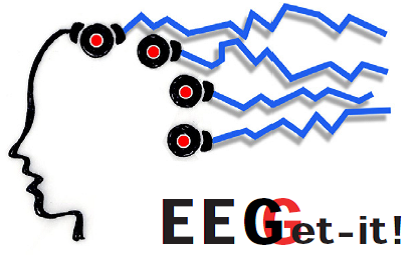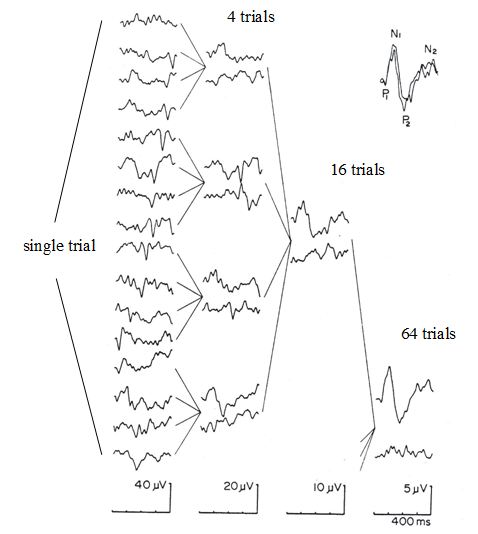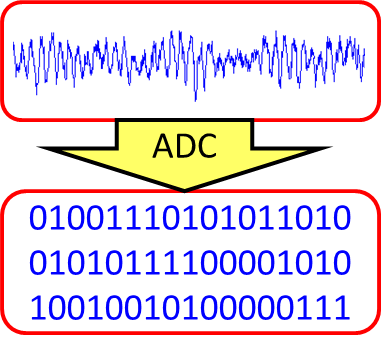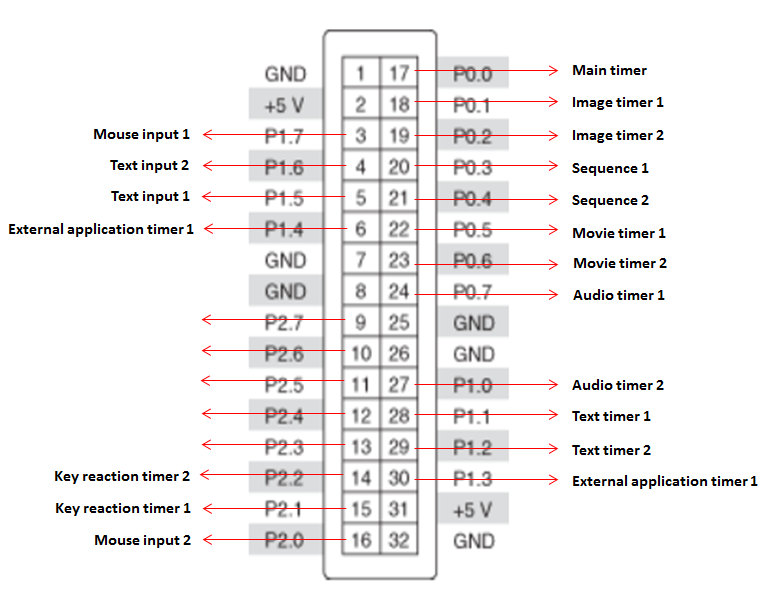Event Related Potentials
by The Team

Principles of Method.
In ERP analysis, the signals of interest are only those electrical potentials in the scalp-recorded EEG that are related to a particular event. Two terms in this definition need further explanation: “only those” and “event”. We start with the latter.
“Event” in this context means (1) a sensory event, like the presentation of a picture or a word on a computer screen, or (2) a motor event, like pressing a response key, or (3) a cognitive event, like the detection (conscious or unconscious) of something unexpected, the anticipation and preparation of a motor response, or the realization that you made a mistake. “Events” thus refer to observable but also unobservable (cognitive) experiences. On the other hand, to calculate ERPs an observable event (stimulus or response) is always needed and the exact timing of it needs to be recorded together with the EEG. In Figure 1, the trigger event corresponds to the presentation of a visual stimulus, and in service of the averaging process (see further) this is repeated n times (S1, S2, S3 …… Sn).

Figure 1: Event-related potential in response to a visual stimulus as obtained by averaging the EEG signal of multiple stimulus presentations (S1, S2,… Sn). Originally published in Purves et al. (2008)
“Only those” implies that there is also EEG activity that is not related to a particular event, which we call noise. This noise may come from the environment (e.g., electric interference) or other parts of the body (e.g., eye movements), but also the brain itself in the form of background activity. This background activity may differ with the “state” in which the person is in, for example, asleep or super alert. In ERP research we are NOT interested in this kind of state-related activity, so together with the other noise, it needs to be reduced or filtered out as much as possible. This is done by making use of the fact that this background activity is not related or time-locked to a particular event – it is random activity. (Please note that ERP researchers could however be interested in how different “states” affect different processing stages)
Averaging.
The noise in a typical EEG recording is much bigger than the event-related EEG signal. A special technique is therefore needed to lift the event-related EEG signal out of the background EEG. This technique is averaging, which means that the “event” we are interested in needs to be repeated (at least 30 times but often many times more).Each repetition is called a trial. Averaging increases the EEG signal that is time-locked to a particular event relative to the random background EEG activity. You can see the results of the averaging process in Figure 2; the ERP gets clearer the more trials are included into the average, while at the same time the noise gets smaller. The signal that comes out of the averaging procedure is the event-related potential (ERP). An ERP is thus per definition an averaged response. In Figure 2, the final ERP is the average of 64 trials.

Figure 2: Averaged waveform of ERP. Leftmost column: 16 single trial ERPs. Second column from left: average ERPs computed across 4 trials (upper waveform of each pair) and an estimate of the noise residual (lower waveform of each pair). Second column from right: average ERP computed across 16 trials (upper waveform) and noise residual (lower waveform). Rightmost column: average ERP computed across 64 trials and noise residual. (From Picton, 1980). Note also the changing scale of the Y-axis.
Peaks and Troughs.
An ERP is characterized by a series of peaks and troughs (see Figure 3), with different latencies (when they occur), amplitudes (how big they are), and scalp distributions (areas on the scalp where they are largest). Through more than 50 years of research, these peaks and troughs have been associated with particular stages of information processing. This has been a painstakingly process with still a lot of disagreements and sensitivities. The problem is that (a) ERPs are always the summation of many different neuron populations from distinct brain areas and (b) information processing occurs in a parallel and not linear fashion. Both these issues make interpretation difficult, but also interesting.
To begin with, you can look at Table 1, describing characteristics of the most known ERP components and the functions or processes they are typically associated with. Some components are linked to a paper, describing in more detail the kind of experiment in which this component can be recorded and what can be learned from it. Note that the P stands for positive and the N for negative (but often this is plotted the-other-way around). The number corresponds to the peak order (first, second, etc) or latency at which it can be observed.

Figure 3: Grand average ERPs (averaged over all participants) recorded in a so-called oddball task: one tone is frequently presented (thin line) and another, deviant tone is presented only 10% of the time (thick line). The participants’ task is to count the number of deviant tones, which thereby becomes the target. Both tones elicit a N1 and P2, but only the target tone elicits a N2, P3a and P3b. The stages of processing that are typically associated with these peaks are described in Table 1.
Table 1: Some well-known ERP components and their associated functions. Please note: characteristics are not set in stone and particularly the latency may vary with task and stimulus conditions. By clicking on a component, you will be directed to an example paper, linking this component to a particular psychological process.
| Components | Latency (ms) | Scalp Distributions | Associated Function |
|---|---|---|---|
| Stimulus Locked | |||
| P1 | 100 | Occipital | Detection of visual stimulus |
| N1 | 110 | Central-Frontal | Detection of auditotry stimulus |
| N170 | 170 | Occipital-Temporal | Detection of a face |
| P2 | 200 | Central | Automatic alerting function |
| N2 | 220 | Central-Frontal | Further processing or inhibition |
| MMN - mismatch negativity | 220 | Central-Frontal | Automatic detection of stimulus deviance (N2 family) |
| P3a (novelty P3) | 270-300 | Central-Frontal | Automatic detection of stimulus deviance or novelty (P3 family) |
| P3b (classic P300) | 300-500 | Central-Parietal | Target detection and stimulus classification |
| LPP-Late Positive Potential | 400-800 | Central-Parietal | Motivated attention (P3 family) – often elicited by emotional pictures |
| N400 | 350-550 | Central | Semantic integration (language, meaning). Reduced in repetition priming paradigms |
| Old/New effects | 350-800 | Frontal-Central-Parietal | Recognition of previously presented information (early-frontal and late-parietal part) |
| Response Locked | |||
| CNV | Central | Stimulus and response anticipation – recorded with fixed stimulus or warning-response intervals | |
| RP-Readiness Potential | -400 | Central Lateralized | Recorded before response: Motor preparation |
| ERN-Error Related Negativity | -70 | Central-Frontal | Recorded after response: Error detection and action monitoring |
Once an association is established between a peak, or part of the ERP waveform, and a particular cognitive process you could derive exactly when this process occurred (based on ERP latency) and how much resources have gone into it (based on ERP amplitude). For example, when the LPP is bigger in condition A as compared to condition B, one could conclude that the stimuli in condition A received more motivational attention than in condition B, for example, because the stimuli in condition A are perceived to be more threatening or more rewarding.
The biggest advantage of ERPs, is that they provide important information of what functionally happens between, for example, the presentation of a stimulus and the participants’ response. In fact, a response is not even needed, and thus ERPs can also provide information when people are not able to respond (e.g., if they are in a coma) or when the task does not require them to do so (e.g., participants are asked to ignore certain stimuli, but these are nevertheless processed).
Describing Components.
Note that suddenly, we have started using the term “component” instead of peak, trough or wave. In fact, this conversion from peaks to components is one of the big discussion points in ERP research. As a rule of thumb you could say that peaks and waves correspond to what is visible in the ERP waveform, whereas components already have a bit of an interpretation in them, referring to what psychological process they possibly reflect (see Table 1) and what the underlying sources might be (note the cautious formulation here, and see citation of Steven Luck below). So, for example you could say that the P1 peak refers to the first positive spike in an ERP waveform that is elicited by a visual stimulus. This is what you observe and this should be objective. In contrast, the P1 component refers to the first positive-going part of the ERP waveform that occurs around 100 ms post-stimulus and that is associated with one of the earliest stages of visual stimulus detection, originating from the visual cortex. You see that a lot of “knowledge” goes into this latter description - this is what the 50 years of research was for! Ideally, you want peaks to be synonymous with components, but that is unfortunately not the case. Indeed, this is a bit tricky for particularly the later waves/components. However, for a beginning ERP researcher, you could do as if. In addition, to avoid discussion, it is better to refer to peaks and waves in the results section, while you link observable peaks to components in the discussion (this will be further explained below).

Prof Steven Luck, University of California “The actual waveform is continuous, with no sudden transitions between one peak and the next, and division of the ERP waveform into discrete peaks is somewhat arbitrary…… Although the peaks are visually salient, there is no a priori reason to believe that each peak reflects a specific brain process.”
Early versus Late components
Early components (earlier than 200 ms) of a sensory ERP depend heavily on the physical characteristics of the presented stimulus. They are sometimes referred to as exogenous components or “evoked” potentials (EP). The early components of a visual ERP are therefore also very different from those of an auditory ERP (e.g., in an auditory ERP a first positive peak is hardly visible). Similarly, the early components in response to a loud noise or a bright light are much bigger than those in response to a soft noise or a dim light. If you are not interested in these physical differences you need to make sure that all the different stimuli that you use (for example red and blue circles) are equally divided over your different experimental conditions (each colored circle should be presented as target and non-target, for example). In addition, early components are typically very small thus many repetitions are needed for the averaging process (for visual ERPs > 50 repetitions and for auditory ERPs > 40 repetitions). They are also fairly localized, meaning that they are visible over some scalp areas and not others. Early components of a visual ERP are best visible over the occipital areas (O1, O2, Oz) whereas those of an auditory ERP are most clearly visible over central and frontal areas (Cz, Fz).
Late ERP components (later than 200 ms) are more task dependent and more variable between people. They are therefore not present in each and every task. Sometimes they are referred to as endogenous components. An N400 for example only occurs in a task that requires participants to access the meaning of a presented stimulus and when this meaning somehow “clashes” with their expectation. For example, simply presenting the word “shoe” will not elicit an N400 unless it is preceded by “ he ate a …”. The N400 also occurs in so-called repetition-priming paradigms, in which it is biggest when it doesn’t match with the meaning of the preceding (priming) stimulus. Thus, the N400 is critically dependent on what is presented before the eliciting stimulus itself. Another example, the classic P300 (or P3b) will be much bigger when the stimuli that elicit it are made task relevant (targets versus non-targets) and when they are infrequently presented (with a chance of 0.1 instead of 0.3). Late components have the advantage that they have a wide scalp distribution (i.e., visible at many electrode locations). They are also bigger, so typically an average of about 25 to 30 trials should still be okay for a reliable ERP.
Optimizing design
When you design your own ERP experiment you need of course follow the general guidelines for experimental design. It is wise to keep close to an existing paradigm and to carefully look at experiments that have investigated a similar topic. In addition, you need to take into account some specific requirements that relate to ERP characteristics. For example, ERPs are averaged responses, so you need to make sure that the event that you are interested in repeatedly occurs in your experiment; but how many times would be enough? Also, ERPs have different durations with no strict boundaries, so when can you present the next stimulus? If ERPs are so sensitive for physical characteristics, how can I make sure they don’t disturb my experiment? Next, some of these ERP-relevant issues are described.
As mentioned before, ERPs are per definition averaged responses. This means that they can only be calculated when the event of interest is repeated. This should be at least 25 times, but if you are interested in early components, many times more. It is difficult to give a guideline here and you are advised to follow target papers in the same topic area (see links in Table 1). In addition, take into account that you will lose EEG data due to artifacts, eye blinks, and movements anyway. So if you want to end up with a minimum of 50 trials per condition, it is safest to present 70 trials of that condition.
On the other hand, participants may get tired or bored when you incorporate too many repetitions, and this should also be considered. Please note that repetition of an event in a particular condition (e.g., a threatening picture) is not the same as repetition of one and the same stimulus. In this example, you could thus, for example, present pictures of snakes, guns, accidents, sharks, spiders, etc. If you do this, try to make sure that these individual stimuli within a set or condition do not deviate too much from each other with respect to characteristics that you are not interested in, like size, luminance, visual detail, etc. Indeed, stimulus selection is an important part of your experimental set-up and many ERP papers devote a separate section/paragraph to it.
ERPs for consecutive stimuli or responses should not overlap with each other. It is therefore necessary to space out events. Inter-stimulus-intervals (ISIs) of 1-1.5 second are very common in ERP literature, as it gives enough time for the late positive components to return to baseline. Often researchers refer to SOAs instead of ISIs. SOA stands for stimulus-onset-asynchrony and reflects the time between the onset of two consecutive stimuli. ISI can mean exactly the same or can mean the time in between the offset of the first stimulus and the onset of the second stimulus (See Figure 4). To avoid confusion, it is thus better to refer to SOA.

Figure 4: The difference between SOA (stimulus onset asynchrony) and ISI (inter stimulus interval)
Ideally you want to vary the SOAs to avoid anticipatory processes which might create a sloping baseline (cf., CNV). Thus, if possible you could for example use randomized SOAs of 1000 ms, 1100 ms, 1200 ms, 1300 ms, 1400 ms, and 1500 ms.
Test Blocks
Because there are so many repetitions involved in ERP research, experiments are often divided in several test blocks (for example, of 4 minutes each). This avoids that participants become too tired, as they can take little breaks between blocks. It is important that the test conditions are equally divided over the test blocks. In principle, each test block should be the same but with different (randomized) presentation orders. If you work with test blocks that are different (for example when they correspond to different task conditions, like with or without feedback) then make sure you counterbalance them between participants to prevent order effects.
ERPs are very sensitive to orienting responses, which could occur at the start of each test block. In ERP research it is therefore common that the first 2-5 trials are not included in the ERP averages. These trials are referred to as filler trials.


